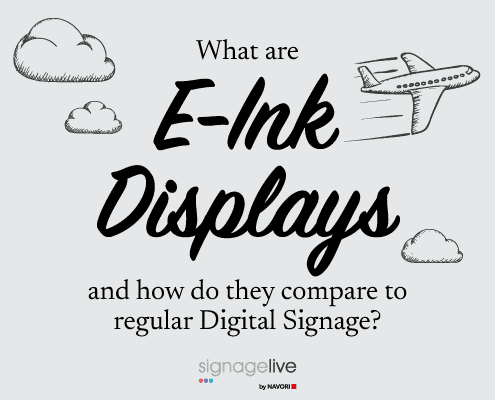Have you rolled out the software and the workplace Digital Signage you need, only to find that you’re still struggling to realise your digital transformation goals?! If this is the case for your business, then you’re far from alone. It’s a surprisingly common issue, with a whopping 70% of businesses reportedly failing to pull off a successful digital transformation. The problem is often due to an unresolved and ongoing mismatch between a company’s business strategy and the digital processes it has in place. The good news is that the issue is easy to fix through the process of mapping your business! This entails reviewing your current systems and developing a digital blueprint of what you need to achieve your business targets. To help you kickstart the process, we have compiled our top ten tips, with the help of Natalia Chelsea Di Palma, VP of Growth Marketing from renowned enterprise transformation software provider, Orbus.
1. Bridge the gap between the means and ends of your strategy
Before you make any changes to your digital systems, ask yourself the following three questions
- What are you hoping to achieve?
- What software and hardware do you need to make this happen?
- How can this software and hardware help to optimise your bottom line, as well as targets for your Annual Recurring Revenue (ARR), Net Revenue Retention (NRR), and ESG (Environmental, Social and Governance)?
Answering these questions will help keep you focussed on what goals are most important to you, and what digital functions can provide the means you need to achieve and surpass them.
2. Flesh out the functionality you need
Next, drill down on the kind of digital features you need. Ask yourself the following questions about the software you have, or plan to use2
- What is the software designed to do?
- How does it support a business process of who needs to use it?
- How does it integrate with the IT dept and regulatory requirements?
These questions will help you conduct an honest review of your current systems and expose any gaps in functionality, performance and integration.
3. Application rationalisation
This will bring you to the next step, which is application rationalisation – a process, which requires you to further evaluate your business rationale for using specific digital functions and reporting. Upon review, you may find that you have multiple systems that do similar things, or features that are largely unused. Alternatively, they might be useful, but perhaps the data they generate is largely unsurfaced. This is where you can start making practical and cost-efficient decisions to maximise productivity, simply by, for example, unsubscribing from duplicate software functions, and unlocking the potential of your data through the use of existing workplace Digital Signage. There are now Digital Signage integrations, which enable you to securely display your data dashboards in near real-time from any business intelligence platform, including Microsoft Power BI. Utilising your Digital Signage to share your data with departments across the business is just one example of how a single digital tool can add value to another, and in the process, help maximise your business performance.
4. Speed of implementation
When you have drawn conclusions about the systems you need, and how they can be better utilised together, you can then start looking at timelines. If you’re installing any new digital tools, or customising the ones you have, what are the timescales, and how will these affect your business? Give yourself a little buffer time to allow for any teething problems, and be sure to test how everything works together, before you scale out. Most importantly, ask yourself whether the time you are taking to implement new systems might actually make them dated and redundant, before you have even had a chance to roll them out.
5. Take a holistic approach
It can sometimes be tempting to look at systems from the perspective of more prominent departments, or even from the viewpoint of specific points in the customer journey. However, if you want to ensure real value, then it’s best to consider how your digital tools can be mapped to work together and add value to the whole business, and across every stage of the customer experience, For example, as Natalia points out, if you are working in transport, you’d need to consider how your systems could work together, so you could use your touchscreen Digital Signage kiosks to broadcast every kind of traveller support. This could include everything from wayfinding and messaging to point of sale, and self-service payment.
6. Future-proof evolution
Your digital ecosystem is a living and breathing entity, that should never stop evolving. You need to allow room for growth and additional related functionality to be added. It’s therefore worth planning ahead and working out how you will scale your systems efficiently, and what other features you might need to build on the performance of your solutions. Consider investing in cloud-based Digital Signage solutions that only require additional screens, and a licence subscription upgrade, when you’re ready to scale out.
7. Creative presentation
Presentation is key, if you’re going to effectively communicate the information you collect, process and analyse with your digital systems. It’s therefore worth taking some time to work out how you are going to communicate your data, and what the best ways are to do so. Can you make use of your existing Digital Signage to help you flesh out an impactful communications strategy? Look out for Digital Signage content management systems (CMS) that are compatible with many of the software systems you use.
8. Eliminate silos
In your analysis of what systems are being used most effectively, you may come to see that some software is being used by one department and not by others. This only encourages departments to work in silos and robs your business of more opportunities to collaborate and share resources and functionality. Try to work out which parts of the system can be centralised and shared across all departments, and which parts can’t.
Ask yourself what each department is trying to measure, where the information comes from and if there are ways you can present the same information differently for alternative audiences. Also, consider investing in a platform, like Asana that is designed to facilitate cross-collaboration between different departments, so it’s immediately clear which resources and information sources can be used by everyone. Some content management platforms come with integrated apps for business intelligence tools like Microsoft Power BI, which enable you to analyse data from different systems, and securely present information in a range of ways across Digital Signage screens on every department floor.
9. Think sustainability
Be sure to factor in your sustainability goals into any digital blueprint. There are plenty of systems, such as Orbus and its ESG lens, that can help you do this. This kind of software is designed to help you lower your carbon footprint, prompting you with a series of questions to help establish how to maximise your efficiency. How are you currently trying to achieve your net zero targets? How are you measuring your greenhouse gas emissions etc? Also, when you are selecting equipment, how are you determining its energy efficiency? Remember, it’s not just the long lifespan of, for instance, hardware, that’s likely to make a product more efficient. It’s the design and build as well as its lifetime costs.
10. Capability modelling
This technique can help you to understand exactly what digital functionality you need to support your individual business practices and fulfil your goals. Think of it this way. If you’re a runner, you need to become more fit, but to do so, you might want to develop more exercises for your legs than, for example, your arms. The point is, that while you should think of your business holistically, as a body in need a full workout, there are bound to be areas that need more work to help you stay ahead of the game. As your business grows and evolves, it’s worth regularly re-evaluating what its needs are and if there are any gaps in your digital functionality.
For more tips and insights, check out our latest episode of Digital Signage Explored with special guest, Natalia Chelsea Di Palma, VP of Growth Marketing from renowned enterprise transformation software provider, Orbus.





You must be logged in to post a comment.